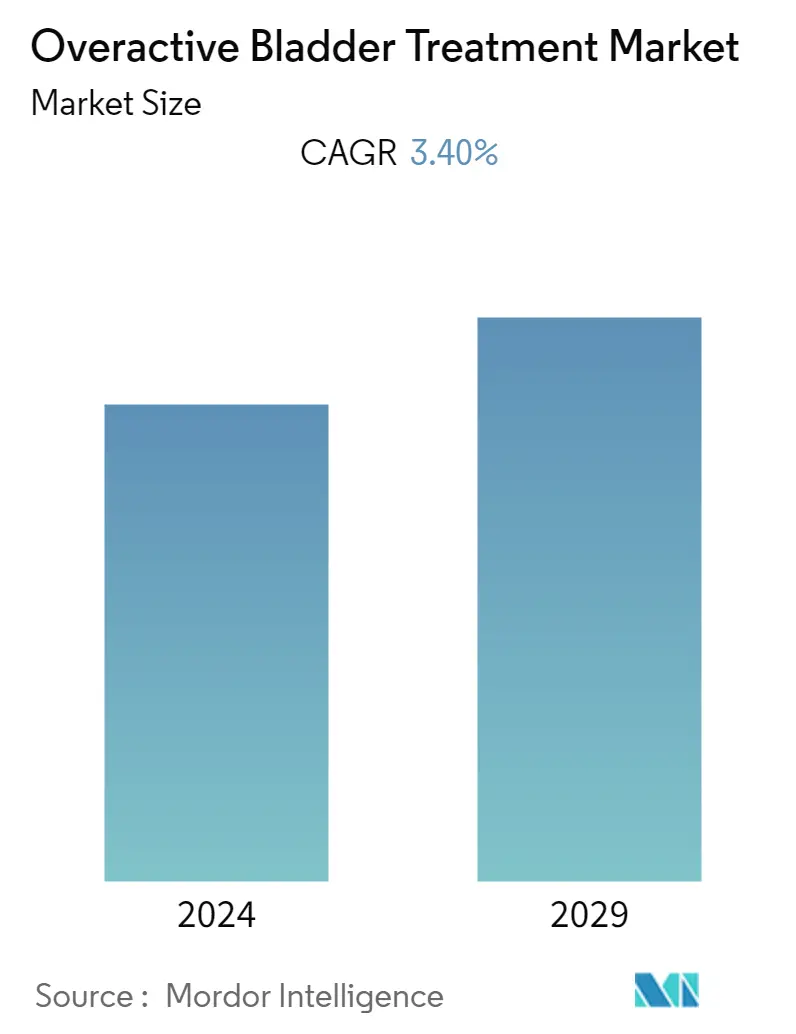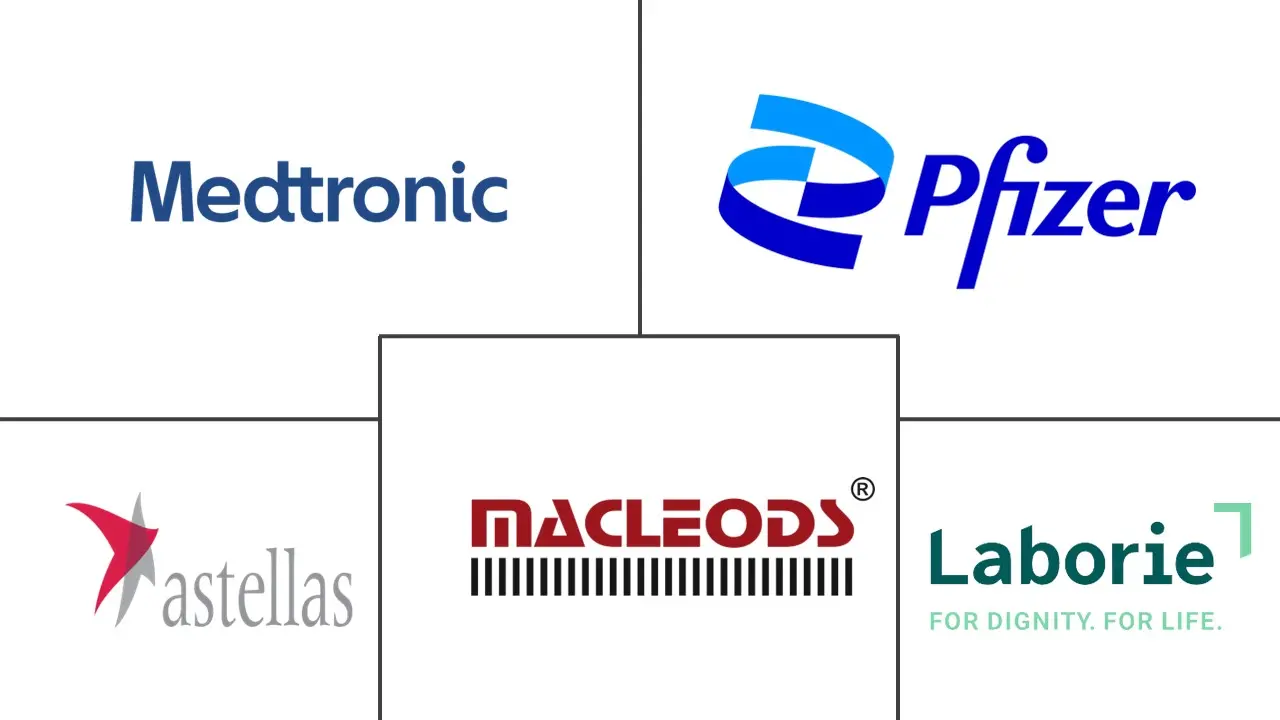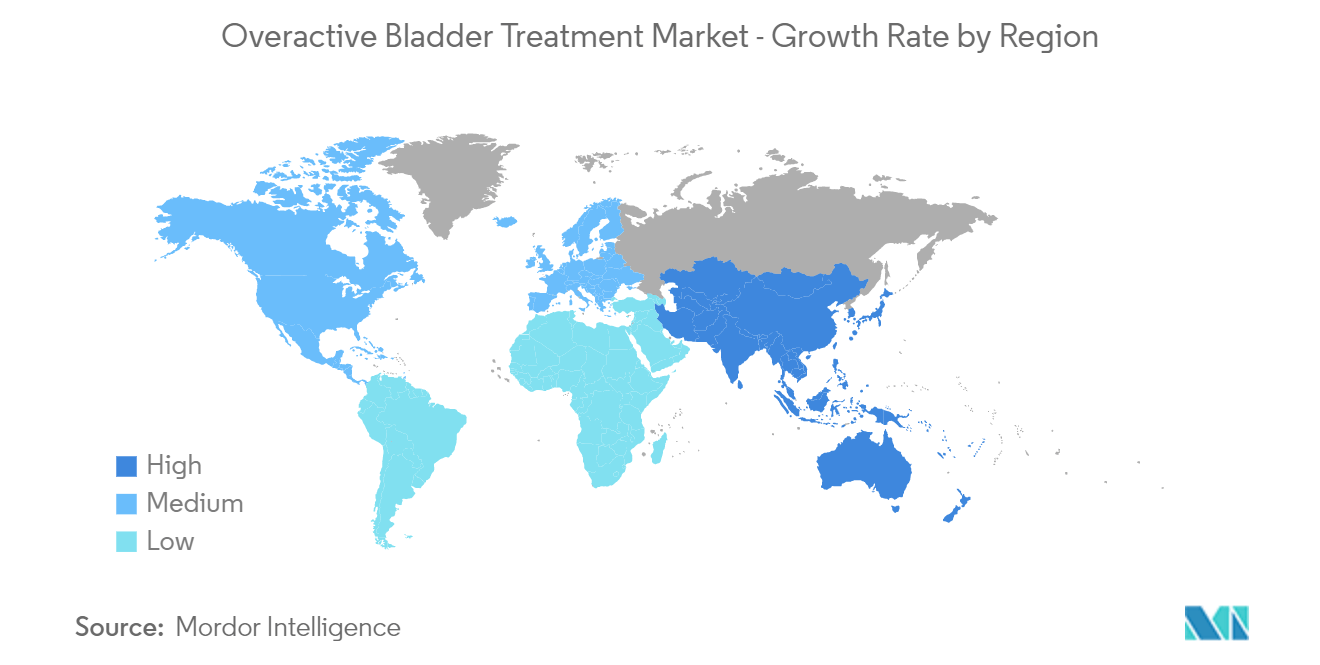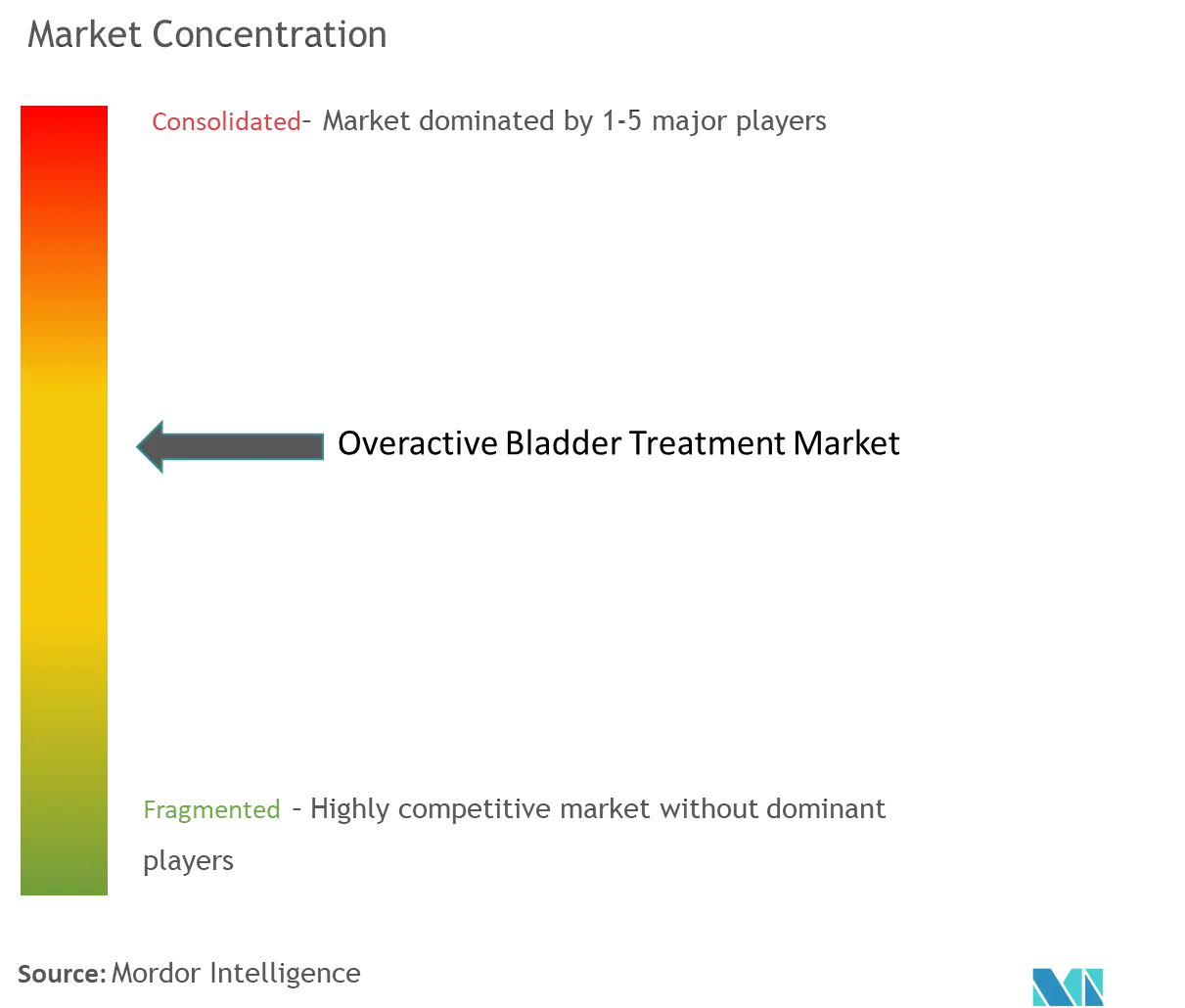Overactive Bladder Treatment (OAB) Market Size

| Study Period | 2019 - 2029 |
| Base Year For Estimation | 2023 |
| CAGR | 3.40 % |
| Fastest Growing Market | Asia Pacific |
| Largest Market | North America |
| Market Concentration | Medium |
Major Players
*Disclaimer: Major Players sorted in no particular order |
Overactive Bladder Treatment (OAB) Market Analysis
The overactive bladder (OAB) treatment market is expected to register a CAGR of 3.4% over the forecast period.
COVID-19 pandemic significantly impacted the overactive bladder treatment market growth due to the high risk of overactive bladder symptoms in the COVID-19 recovered patients. For instance, as per the study published by Springer Journal in November 2021, patients were reported with worsening overactive bladder symptoms 10-14 weeks after hospitalisation with COVID-19. Similarly, according to an article published by the Elsevier Journal in October 2022, individuals with positive COVID-19 cases were at higher risk of worsening overactive bladder (OAB) symptoms. Therefore, the COVID-19 infection rate associated with overactive bladder symptoms increased the demand for overactive bladder treatments amid the pandemic. However, with the reduction of COVID-19 cases, the need for OAB drugs for COVID-19 patients is expected to show stable growth during the forecast period.
The primary factor driving the market growth include the rising prevalence of various diseases that causes overactive bladder, such as urinary tract infections (UTI), diabetes, bladder cancer, and neurological disorders like Parkinson's disease and stroke. UTIs occur when bacteria enter the urinary tract and cause infection. In addition to pain and burning during urination, UTIs lead to overactive bladder symptoms, including frequent urination and urgency. For instance, according to an article published by the StatPearls Journal in November 2022, approximately 40% of women in the United States are estimated to develop a urinary UTI once in their lifetime. Therefore, the high prevalence of UTI will drive the demand for OAB treatment drugs during the forecast period. In addition, diabetes, particularly uncontrolled diabetes, can affect the nerves that control the bladder, leading to overactive symptoms. High blood sugar levels can damage the nerves over time, causing issues with bladder control. Hence, the increasing prevalence of diabetes may also lead to an increase in the OAB burden. For instance, according to the December 2021 report of the IDF Diabetes Atlas, approximately 537 million adults were living with diabetes worldwide in 2021, and the number was projected to increase to 643 million by 2030 and 783 million by 2045. Thus, owing to the high prevalence of risk factors, the burden of OAB is expected to increase, thereby driving the demand for OAB therapeutics.
Moreover, the increasing number of ongoing clinical trials and novel drug approvals is also projected to augment market growth. The surge in clinical trials is projected to drive market growth by introducing novel OAB treatment drugs. For instance, in May 2022, Urovant Sciences presented data from the Phase 3 EMPOWUR Extension Study of GEMTESA(vibegron) 75 mg overactive bladder treatment drug therapy. It will further confirm this drug's potential utility and durability in this patient population and examine the long-term effects of the product. The drug showed sustained reductions in average daily micturition, urge urinary incontinence (UUI) episodes and urgency episodes. Hence, as more drugs complete clinical trials and receive regulatory approvals, the market will witness a surge in innovative therapies, enhancing patient outcomes and fostering market growth.
Thus, owing to the rising prevalence of various disorders like UTI and diabetes and the surging number of ongoing clinical trials of OAB treatment drugs, the market is expected to project growth over the forecast period. However, alternative treatment options such as physical therapies and surgeries may impede the market growth during the study period.
Overactive Bladder Treatment (OAB) Market Trends
Neurostimulation Segment is Expected to Hold a Significant Share Over the Forecast Period
Neurostimulation is a minimally invasive technique used in OAB treatment, which delivers electrical impulses to the nerves involved in bladder control. The implantable device is placed near the sacral nerves through surgery or a percutaneous approach. Controlled electrical stimulation helps regulate bladder activity, alleviating urgency and frequency and improving control, providing an alternative treatment for patients unresponsive to other therapies.
The major factors driving the segment growth include the high prevalence of the OAB and wide acceptance of neurostimulation treatment amongst patients who are irresponsive to drugs such as Anticholinergics and Mirabegron. According to an article published by the NCBI in May 2023, Sacral neuromodulation (SNM) is a highly adopted procedure for OAB treatment in the United States for patients unresponsive to pharmacologic therapy owing to its high efficacy, safety, and minimally invasive nature. The same source mentioned that the treatment is highly prominent in Canada and Europe for treating urinary incontinence, urinary retention, urgency, frequency, and faecal incontinence. Therefore, compared to more invasive procedures, such as surgery, neurostimulation is considered safer and more appealing, attracting more patients and driving market growth. The strategic initiatives the market players take, such as active participation in the launch of novel OAB therapies, are also expected to propel the market segment's growth. For instance, in March 2022, Valencia Technologies Corporation received United States Food and Drug Administration (FDA) premarket approval (PMA) for its eCoin leadless tibial neurostimulator for the treatment of urinary urge incontinence (UUI), which affects over 60% of patients who suffer from overactive bladder (OAB).
Thus, owing to the high preference for neurostimulation therapy and the rising number of product launches, the market segment is expected to project significant growth over the forecast period.

North America is Expected to Hold a Significant Share in the Market Over the Forecast Period
North America is expected to hold a significant share in the overactive bladder treatment market during the forecast period owing to the rising prevalence of OAB and the rising number of product launches in the region. For instance, according to the article published by the Canadian Urological Association Journal in March 2023, an estimated 18% of Canadians are currently suffering from OAB, with around 24% having difficulty adhering to pharmacotherapy. Therefore, the high number of people suffering from OAB in Canada is projected to drive the demand for various treatment therapies, such as neurostimulation and intravesical instillation, during the forecast period.
Furthermore, the rising number of partnerships and novel drug launches by prominent regional players is also projected to accelerate regional market growth during the forecast period. For instance, in November 2022, Urovant Sciences partnered with Thinx Inc to launch Time To Go, a multi-channel educational campaign to highlight the impact of OAB and introduce options for managing symptoms of OAB amongst Americans. In addition, in July 2022, Dr Reddy's Laboratories Ltd. Launched Fesoterodine Fumarate Extended-Release Tablets, a generic therapeutic equivalent to Toviaz in the United States.
Therefore, with the surging number of people affected by OAB, the rising number of partnerships to increase awareness regarding OAB, and the introduction of novel therapies, the market is expected to offer lucrative growth opportunities in the region during the forecast period.

Overactive Bladder Treatment (OAB) Industry Overview
The overactive bladder treatment market is moderately competitive due to the presence of several players in the market. Some of the key players in the market are AbbVie Inc., Astellas Pharma Inc., Laborie, Endo International PLC, Hisamitsu Pharmaceutical Co., Inc., and Macleods, among others.
Overactive Bladder Treatment (OAB) Market Leaders
-
Medtronic PLC
-
Astellas Pharma, Inc.
-
Macleods Pharmaceuticals Ltd
-
Pfizer, Inc
-
AbbVie Ltd.
*Disclaimer: Major Players sorted in no particular order

Overactive Bladder Treatment (OAB) Market News
- In March 2023, MSN Laboratories launched the generic version of Fesoterodine Fumarate, Fesobig, a first-line pharmacotherapy option for treating OAB.
- In January 2023, Alembic Pharmaceuticals Limited received the US FDA approval for its Abbreviated New Drug Application (ANDA), Fesoterodine Fumarate tablets, for treating OAB in adults.
Overactive Bladder Treatment (OAB) Market Report - Table of Contents
1. INTRODUCTION
- 1.1 Study Assumptions and Market Definition
- 1.2 Scope of the Study
2. RESEARCH METHODOLOGY
3. EXECUTIVE SUMMARY
4. MARKET DYNAMICS
- 4.1 Market Overview
-
4.2 Market Drivers
- 4.2.1 Increasing Prevalence of Overactive Bladder and its Risk Factors
- 4.2.2 Increasing Research Investments and Novel Drug Launches
-
4.3 Market Restraints
- 4.3.1 Presence of Alternative Treatment Options such as Physical Therapies and Surgeries
-
4.4 Porter's Five Forces Analysis
- 4.4.1 Threat of New Entrants
- 4.4.2 Bargaining Power of Buyers/Consumers
- 4.4.3 Bargaining Power of Suppliers
- 4.4.4 Threat of Substitute Products
- 4.4.5 Intensity of Competitive Rivalry
5. MARKET SEGMENTATION (Market Size by Value - in USD million)
-
5.1 By Therapy
- 5.1.1 Anticholinergics
- 5.1.2 Mirabegron
- 5.1.3 Neurostimulation
- 5.1.4 Intravesical Instillation
- 5.1.5 Other Therapies
-
5.2 By Disease Type
- 5.2.1 Idiopathic Overactive Bladder
- 5.2.2 Neurogenic Overactive Bladder
-
5.3 Geography
- 5.3.1 North America
- 5.3.1.1 United States
- 5.3.1.2 Canada
- 5.3.1.3 Mexico
- 5.3.2 Europe
- 5.3.2.1 Germany
- 5.3.2.2 United Kingdom
- 5.3.2.3 France
- 5.3.2.4 Italy
- 5.3.2.5 Spain
- 5.3.2.6 Rest of Europe
- 5.3.3 Asia-Pacific
- 5.3.3.1 China
- 5.3.3.2 Japan
- 5.3.3.3 India
- 5.3.3.4 Australia
- 5.3.3.5 South Korea
- 5.3.3.6 Rest of Asia-Pacific
- 5.3.4 Middle East and Africa
- 5.3.4.1 GCC
- 5.3.4.2 South Africa
- 5.3.4.3 Rest of Middle East and Africa
- 5.3.5 South America
- 5.3.5.1 Brazil
- 5.3.5.2 Argentina
- 5.3.5.3 Rest of South America
6. COMPETITIVE LANDSCAPE
-
6.1 Company Profiles
- 6.1.1 AbbVie Inc. (Allergan)
- 6.1.2 Astellas Pharma Inc.
- 6.1.3 Laborie
- 6.1.4 Endo International PLC
- 6.1.5 Hisamitsu Pharmaceutical Co., Inc.
- 6.1.6 Medtronic
- 6.1.7 Pfizer Inc.
- 6.1.8 Teva Pharmaceutical Industries Ltd
- 6.1.9 Macleods Pharmaceuticals Ltd
- 6.1.10 Urovant Sciences
- 6.1.11 Uro Medical
- *List Not Exhaustive
7. MARKET OPPORTUNITIES AND FUTURE TRENDS
** Subject To AvailablityOveractive Bladder Treatment (OAB) Industry Segmentation
As per the scope of the report, an overactive bladder, also known as OAB, causes a frequent and sudden urge to urinate that may be difficult to control. Overactive bladder treatments are used to treat the sudden involuntary contraction of the muscle in the urinary bladder wall, leading to urinary urgency, frequency, nocturia, and urge incontinence. The Overactive Bladder Treatment Market is Segmented by Therapy (AntiCholinergics, Mirabegron, Neurostimulation, Intravesical Instillation, and Other Therapies), Disease Type (Idiopathic Overactive Bladder and Neurogenic Overactive Bladder), and Geography (North America, Europe, Asia-Pacific, Middle East and Africa, and South America). The report also covers the estimated market sizes and trends for 17 countries across major regions globally. The report offers the value (in USD million) for the abovementioned segments.
| By Therapy | Anticholinergics | |
| Mirabegron | ||
| Neurostimulation | ||
| Intravesical Instillation | ||
| Other Therapies | ||
| By Disease Type | Idiopathic Overactive Bladder | |
| Neurogenic Overactive Bladder | ||
| Geography | North America | United States |
| Canada | ||
| Mexico | ||
| Geography | Europe | Germany |
| United Kingdom | ||
| France | ||
| Italy | ||
| Spain | ||
| Rest of Europe | ||
| Geography | Asia-Pacific | China |
| Japan | ||
| India | ||
| Australia | ||
| South Korea | ||
| Rest of Asia-Pacific | ||
| Geography | Middle East and Africa | GCC |
| South Africa | ||
| Rest of Middle East and Africa | ||
| Geography | South America | Brazil |
| Argentina | ||
| Rest of South America |
Overactive Bladder Treatment (OAB) Market Research FAQs
What is the current Overactive Bladder Treatment Market size?
The Overactive Bladder Treatment Market is projected to register a CAGR of 3.40% during the forecast period (2024-2029)
Who are the key players in Overactive Bladder Treatment Market?
Medtronic PLC, Astellas Pharma, Inc., Macleods Pharmaceuticals Ltd, Pfizer, Inc and AbbVie Ltd. are the major companies operating in the Overactive Bladder Treatment Market.
Which is the fastest growing region in Overactive Bladder Treatment Market?
Asia Pacific is estimated to grow at the highest CAGR over the forecast period (2024-2029).
Which region has the biggest share in Overactive Bladder Treatment Market?
In 2024, the North America accounts for the largest market share in Overactive Bladder Treatment Market.
What years does this Overactive Bladder Treatment Market cover?
The report covers the Overactive Bladder Treatment Market historical market size for years: 2019, 2020, 2021, 2022 and 2023. The report also forecasts the Overactive Bladder Treatment Market size for years: 2024, 2025, 2026, 2027, 2028 and 2029.
Overactive Bladder Treatment Industry Report
Statistics for the 2024 Overactive Bladder Treatment market share, size and revenue growth rate, created by Mordor Intelligence™ Industry Reports. Overactive Bladder Treatment analysis includes a market forecast outlook to 2029 and historical overview. Get a sample of this industry analysis as a free report PDF download.



